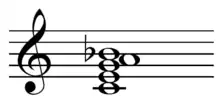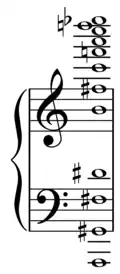Seven six chord
In music, a seven six chord is a chord containing both factors a sixth and a seventh above the root, making it both an added chord and a seventh chord. However, the term may mean the first inversion of an added ninth chord (E–G–C–D).[1]

Seven six chord on C (C7/6). ⓘ
It can be written as 7/6 and 7,6.[2] It can be represented by the integer notation {0, 4, 7, 9, 10}.
This is known more commonly as the 13th chord, with both the dominant 7th and the 6th (or 13th). The chord therefore contains the 5, 6, 7, & 8 (root), which can be spread or clustered. Playing the 13th note extension (or 6th) without the dominant 7th is known as an Add 6 (+6) chord.
| Component intervals from root | |
|---|---|
| minor seventh | |
| major sixth | |
| perfect fifth | |
| major third | |
| root | |
| Tuning | |
| 12:15:18:20:21 | |
| Forte no. / | |
| 5-25 / |
Six seven chord table
| Chord | Root | Major third | Perfect fifth | Major sixth | Minor seventh |
|---|---|---|---|---|---|
| C7/6 | C | E | G | A | B♭ |
| C♯7/6 | C♯ | E♯ (F) | G♯ | A♯ | B |
| D♭7/6 | D♭ | F | A♭ | B♭ | C♭ |
| D7/6 | D | F♯ | A | B | C |
| D♯7/6 | D♯ | F |
A♯ | B♯ (C) | C♯ |
| E♭7/6 | E♭ | G | B♭ | C | D♭ |
| E7/6 | E | G♯ | B | C♯ | D |
| F7/6 | F | A | C | D | E♭ |
| F♯7/6 | F♯ | A♯ | C♯ | D♯ | E |
| G♭7/6 | G♭ | B♭ | D♭ | E♭ | F♭ (E) |
| G7/6 | G | B | D | E | F |
| G♯7/6 | G♯ | B♯ (C) | D♯ | E♯ (F) | F♯ (G♭) |
| A♭7/6 | A♭ | C | E♭ | F | G♭ |
| A7/6 | A | C♯ | E | F♯ | G |
| A♯7/6 | A♯ | C |
E♯ (F) | F |
G♯ |
| B♭7/6 | B♭ | D | F | G | A♭ |
| B7/6 | B | D♯ | F♯ | G♯ | A |
References
This article is issued from Wikipedia. The text is licensed under Creative Commons - Attribution - Sharealike. Additional terms may apply for the media files.
